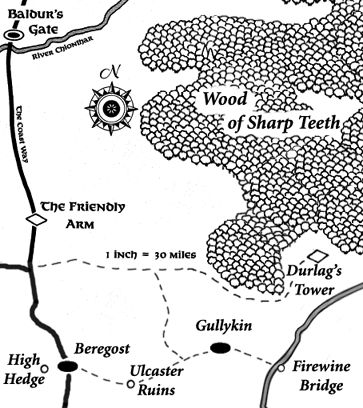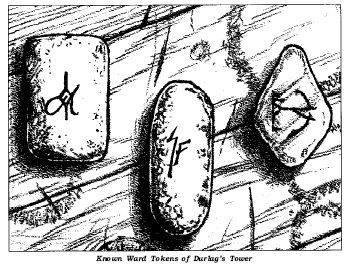This massive, isolated keep stands atop a rock pinnacle south of the Wood of Sharp Teeth. Only adventurers should approach this seemingly deserted fortress, death awaits within. The tower was built by Durlag Trollkiller, son of Bolhur “Thunderaxe” the Clanless. Durlag was a great hero of the dwarves, an adventurer who slew several dragons single-handedly and over a long and successful career amassed a great hoard of treasure. One dwarf who dwelt in the tower with Durlag for a time spoke of rooms full of gems and a great hall strewn with dusty heaps of gold coins. “We took what we needed, freely,” he said.
With the aid of hired dwarves, Durlag dug many chambers and passages in the tor and raised the lone tower above it, planning it as a seat where he could found a dwarven community and grow old in peace, surrounded by happy, prosperous kin. Instead, dopplegangers, organized and aided by foul mind flayers, slew and impersonated Durlag’s companions. After the shocked dwarf discovered the first impersonation, he was attacked by all the others and spent a terror-filled tenday frantically fighting his way around his own fortress, chased by monsters who wore dwarven forms but sought his death.

Touching certain rungs causes all of them to retract into the stone so that climbers fall, or triggers metal blades to shoot out from the seams between the stone wall blocks, transfixing climbers. Deeply suspicious of all Faerûn, anyone could be a foe seeking to betray him for his gold!, Durlag retreated inside his tower, defending it against the adventurers he knew would come, lured by tales the trapbuilders would inevitably tell.
They came, and fell or fled before the traps and the axe of Durlag himself, who would creep up via secret passages to strike from the shadows. For several centuries things went on like this, as the increasingly eccentric Durlag lived on fungi and mushrooms growing in the deepest caverns, and, it is cruelly whispered, the bodies of intruders (although this has never been substantiated). At length he died, and presumably his bones still lie in some inner room or passage, guarded, along with his riches, by the thousands of traps built to defend his home. Every season adventurers mount new expeditions to Durlag’s Tower from Baldur’s Gate and Waterdeep, armed by the exhaustive maps and notes of earlier bands. Every year, they get a room or two deeper into the deadly maze before giving up and bringing back the bodies of those victims they could get out. Unfortunately, in recent years the tower has acquired new inhabitants: a dozen or more will o’ wisps that seem to work in organized groups to battle those who win past the traps, and that feed on those who perish in them. Some say the will o’ wisps are led or directed by a gigantic wisp with fey spell-hurling powers, but others report seeing illithids accompanying the wisps. Some hold the view that the mind flayers are controlling the wisps, and others that the mind flayers are servants of the rumoured Over-Wisp just as the lesser wisps are. The truth remains a mystery for now, and will be revealed, I suspect, only at a very high price in the lives of adventurers.

A trio of these are depicted above. Durlag’s Tower has become a tourist attraction. Enterprising merchants in Baldur’s Gate, Berdusk, Beregost, and Nashkel mount expeditions to view it for 50 gp a head, round trip, all meals included. Such trips usually feature hunting along the way and always include a daytime foray into a few of the well-known tower chambers, their traps tastefully adorned with skeletons and warnings that the tower is haunted. (The water of the forecourt well is safe to drink, but lone travellers using it should beware lurking brigands and the occasional bugbear.) From a nearby camp, sightseeing trips always return to the keep by moonlight, to see the haunted forecourt of the tower. Strange cries, hurled stone axes, and flitting, ghostly apparitions are provided by accomplices of the tour guides. Such sham horrors are sometimes taken advantage of by wandering will o’ wisps or brigands, which is why such expeditions still carry a cachet of danger up and down the Sword Coast, and the legend of Durlag’s Tower grows from year to year. I have myself seen one apparition at the tower gates: the silent figure of a robed mage, standing in midair about as high off the ground as two tall men standing one on the other’s shoulders. He faced the tower, raised his hands to cast some unknown spell, then acquired a look of fear, trembled, and his body was swept away as if torn by unseen winds or claws coming from the tower. This phantom is known to appear often, but no one knows who the mage is, or was, and what he was doing when he died so spectacularly.
